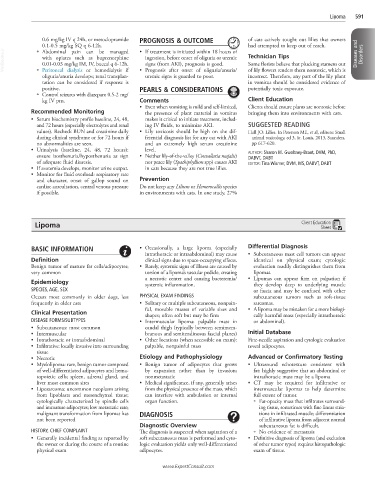Page 1182 - Cote clinical veterinary advisor dogs and cats 4th
P. 1182
Lipoma 591
0.6 mg/kg IV q 24h, or metoclopramide PROGNOSIS & OUTCOME of cats actively sought out lilies that owners
0.1-0.5 mg/kg SQ q 6-12h. • If treatment is initiated within 18 hours of had attempted to keep out of reach.
VetBooks.ir with opiates such as buprenorphine ingestion, before onset of oliguria or uremic Technician Tips Diseases and Disorders
○ Abdominal pain can be managed
0.01-0.03 mg/kg IM, IV, buccal q 6-12h.
signs (from AKI), prognosis is good.
Some florists believe that plucking stamens out
○ Peritoneal dialysis or hemodialysis if
oliguria/anuria develops; renal transplan- • Prognosis after onset of oliguria/anuria/ of lily flowers renders them nontoxic, which is
incorrect. Therefore, any part of the lily plant
uremic signs is guarded to poor.
tation can be considered if response is in vomitus should be considered evidence of
positive. PEARLS & CONSIDERATIONS potentially toxic exposure.
○ Control seizures with diazepam 0.5-2 mg/
kg IV prn. Comments Client Education
• Even when vomiting is mild and self-limited, Clients should ensure plants are nontoxic before
Recommended Monitoring the presence of plant material in vomitus bringing them into environments with cats.
• Serum biochemistry profile baseline, 24, 48, makes it critical to initiate treatment, includ-
and 72 hours (especially electrolytes and renal ing IV fluids, to minimize AKI. SUGGESTED READING
values). Recheck BUN and creatinine daily • Lily toxicosis should be high on the dif- Hall JO: Lilies. In Peterson ME, et al, editors: Small
during clinical syndrome or for 72 hours if ferential diagnosis list for any cat with AKI animal toxicology, ed 3, St. Louis, 2013, Saunders,
no abnormalities are seen. and an extremely high serum creatinine pp 617-620.
• Urinalysis (baseline, 24, 48, 72 hours): level. AUTHOR: Sharon M. Gwaltney-Brant, DVM, PhD,
ensure isosthenuria/hyposthenuria as sign • Neither lily-of-the-valley (Convallaria majalis) DABVT, DABT
of adequate fluid diuresis. nor peace lily (Spathiphyllum spp) causes AKI EDITOR: Tina Wismer, DVM, MS, DABVT, DABT
• If azotemia develops, monitor urine output. in cats because they are not true lilies.
• Monitor for fluid overload: respiratory rate
and character, onset of gallop sound on Prevention
cardiac auscultation, central venous pressure Do not keep any Lilium or Hemerocallis species
if possible. in environments with cats. In one study, 27%
Lipoma Client Education
Sheet
BASIC INFORMATION • Occasionally, a large lipoma (especially Differential Diagnosis
intrathoracic or intraabdominal) may cause • Subcutaneous mast cell tumors can appear
Definition clinical signs due to space-occupying effects. identical on physical exam; cytologic
Benign tumor of mature fat cells/adipocytes; • Rarely, systemic signs of illness are caused by evaluation readily distinguishes them from
very common torsion of a lipoma’s vascular pedicle, creating lipomas.
a necrotic center and causing bacteremia/ • Lipomas can appear firm on palpation if
Epidemiology systemic inflammation. they develop deep to underlying muscle
SPECIES, AGE, SEX or fascia and may be confused with other
Occurs most commonly in older dogs, less PHYSICAL EXAM FINDINGS subcutaneous tumors such as soft-tissue
frequently in older cats • Solitary or multiple subcutaneous, nonpain- sarcomas.
ful, movable masses of variable sizes and • A lipoma may be mistaken for a more biologi-
Clinical Presentation shapes; often soft but may be firm cally harmful mass (especially intrathoracic
DISEASE FORMS/SUBTYPES • Intermuscular lipoma: palpable mass in or abdominal).
• Subcutaneous: most common caudal thigh (typically between semimem-
• Intermuscular branous and semitendinosus fascial planes) Initial Database
• Intrathoracic or intraabdominal • Other locations (when accessible on exam): Fine-needle aspiration and cytologic evaluation
• Infiltrative: locally invasive into surrounding palpable, nonpainful mass reveal adipocytes.
tissue
• Necrotic Etiology and Pathophysiology Advanced or Confirmatory Testing
• Myelolipoma: rare, benign tumor composed • Benign tumor of adipocytes that grows • Ultrasound echotexture consistent with
of well-differentiated adipocytes and hema- by expansion rather than by invasion; fat: highly suggestive that an abdominal or
topoietic cells; spleen, adrenal gland, and nonmetastatic intrathoracic mass may be a lipoma
liver most common sites • Medical significance, if any, generally arises • CT may be required for infiltrative or
• Liposarcoma: uncommon neoplasm arising from the physical presence of the mass, which intermuscular lipomas to help determine
from lipoblasts and mesenchymal tissue; can interfere with ambulation or internal full extent of tumor.
cytologically characterized by spindle cells organ function. ○ Fat-opacity mass that infiltrates surround-
and immature adipocytes; low metastatic rate; ing tissue, sometimes with fine linear stria-
malignant transformation from lipomas has DIAGNOSIS tions in infiltrated muscle; differentiation
not been reported of infiltrative lipoma from adjacent normal
Diagnostic Overview subcutaneous fat is difficult.
HISTORY, CHIEF COMPLAINT The diagnosis is suspected when aspiration of a ○ No evidence of metastasis
• Generally incidental finding as reported by soft subcutaneous mass is performed and cyto- • Definitive diagnosis of lipoma (and exclusion
the owner or during the course of a routine logic evaluation yields only well-differentiated of other tumor types) requires histopathologic
physical exam adipocytes. exam of tissue.
www.ExpertConsult.com

